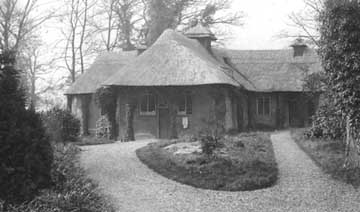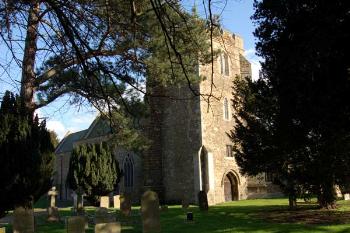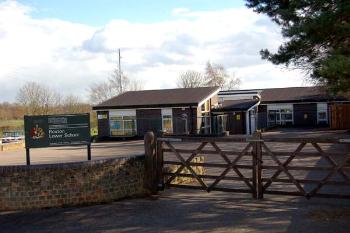Education in Roxton
Early Education in Roxton
The Bishop of Lincoln carried out visitations to Bedfordshire in 1717 and 1720 and for both of these a list of questions was sent out in advance, one of which enquired about the provision of schools in each parish. It was reported to the Bishop at both visitations that there were no public or charity schools in Roxton. The only education was provided by the vicar who taught a private school.
In 1818 a Select Committee was established to enquire into educational provision for the poor. This was no doubt prompted, in part, by the recent foundation of two societies promoting education and specifically the building of schools. The Society for Promoting the Lancasterian System for the Education of the Poor was established in 1808 promoting schools run along the lines pioneered by Joseph Lancaster, who had himself copied those of Dr.Andrew Bell, in which older children taught their younger fellows. The Society was renamed the British and Foreign School Society in 1814,. It was supported by a number of prominent nonconformists, Lancaster himself was a Quaker, and sought to teach a non-sectarian curriculum. In answer to this perceived nonconformist takeover of local education the National Society was formed in 1811 to encourage the teaching of poor children along Anglican lines, including the catechism. The Select Committee sent a questionnaire to all parishes in the country asking for: particulars relating to endowments for the education of children; other educational institutions; observations of parish needs etc. J Clarkson, vicar of Great Barford , stated in the return for Roxton that: "The poor under 16 years of age are chiefly indebted to Dissenters and Methodists for education; and the minister is endeavouring to establish a Sunday school, as there are 60 children in need of instruction". In those days a Sunday School was just that, a school which met on a Sunday, usually in the church or nonconformist chapel or other similar building, teaching more than the religious topics with which they are associated today.
In the country generally the number of schools built continued to grow over the next fifteen years so that by 1833 the government agreed to supplement the work of the two societies, and local benefactors, by making £20,000 per annum available in grants to help build schools. It also prompted another questionnaire to be sent to each parish in England asking for details of local educational provision.

Roxton Congregational Chapel [Z1130/67]
Congregationalism was strong in Roxton, encouraged by the Metcalfe family who owned the Roxton Estate. The 1833 return states that there was a Congregational Infant school, which was attended by 27 children. A Congregational daily school had been started that year and taught 48 children, of whom 17 boys also attended in the evenings in the winter. The schools were supported by donations as well as payments from parents. There were also two Sunday schools – the Church of England school taught 30 boys; and the Congregational was attended by 42 boys and 80 girls. Both Sunday schools were supported by voluntary contributions. 43 children in the Day and Infant schools also attended the Sunday schools.
In 1836 a grant of £50 was made by the British & Foreign Schools Society for a new school at Roxton to accommodate 100 children, this was to replace the barn in which the Congregationalist school was held. The next national enquiry was in 1846/7 when the Church of England made an enquiry as to all its church schools. This was against the background of a new Whig government which championed secular education and the increasing importance of nonconformists, particularly Wesleyan Methodist, and Roman Catholics in providing schools. The Roxton return recorded that there was no church school in the parish, a Sunday School for boys being held in the church and for girls in an outhouse of the Vicarage: "The people are miserably poor and there are no resident gentry". In 1847 a directory states that the British School with fees of 1d to 3d a week according to the nature of the tuition. There is no further mention of this school which seems to have ceased to exist around the time when the National School finally opened in 1860.

Roxton National School
In 1859 a piece of meadow land was given to the church so that they could build a school for ‘the education of children and adults, or children only, of the poorer classes in Roxton". [SDRoxton4/1] The school was to be run by a committee including the minister and churchwardens. The Master or Mistress had to be a member of the Church of England. The school was opened the following year.
The first Education Act was passed in 1870 (more correctly it was known as the Elementary Education Act). It was a milestone in the provision of education in Britain demonstrating central government's unequivocal support for education of all classes across the country. It also sought to secularise education by allowing the creation of School Boards. These were groups of representatives, elected by the local ratepayers and the Board had the powers to raise funds to form a local rate to support local education, build and run schools, pay the fees of the poorest children, make local school attendance compulsory between the ages of 5 and 13 and could even support local church schools, though in practice they replaced them, turning them into Board run schools (known as Board Schools). Naturally, and luckily for local historians, the Act required a questionnaire of local schools in 1870, that for Roxton indicating that the National School had accommodation for 117 children.
The school Punishment Book gives some examples of bad behaviour and the type of punishments which were handed out [SDRoxton3/1]:
- May 24th 1906 - Mabel Stoker, 10, was given two strokes for being "lazy and sulky";
- November 5th 1907 - Alfred Darrington aged 10, was given two strokes for "absenting himself to drive cows without mother’s permission";
- December 11th 1933 - 13 children given two strokes and 4 given one stroke for "leaving the premises without permission to slide on the pond at playtime"
20th Century Education in Roxton
A land mark Education Act was passed in 1902, coming into effect in 1903. It disbanded the School Boards and gave day to day running of education to newly formed Local Education Authorities, usually the county council, as in Bedfordshire. The old Board Schools thus became Council Schools whilst the old National, British and other non-Board schools became known as Public Elementary Schools. Roxton was such a school.
Bedfordshire & Luton Archives & Records Service has a scrapbook of cuttings of visits made to most Bedfordshire Schools by School Inspectors for a period from just before the First World War through the inter-war years [E/IN1/1]. In 1910 the Inspector found: "This School is a very disappointing one. The Master works hard but, owing to ill-directed efforts the results are not commensurate with the energy expended. The chief fault is want of thoroughness which characterises the work". In 1912 the Inspector found: "The School has improved very greatly since the present Head Master took charge of it two years ago. Then its condition was in all respects very far from satisfaction but now, Tone, Order, and Instruction are all deserving of praise. The premises are poor in many ways, and stand in urgent need of improvement in arrangements for warming before the coming winter. After that I hope the question of better ventilation and more sanitary offices [i.e. toilets] will receive due consideration from the Managers". The Managers responded thus: "The Managers wish me to say they will do all in their power to keep the children warm. There is no evidence of any child suffering from cold in Winter. The temperature necessarily varies much with the position of the Thermometer, and it is difficult to believe that with an average attendance of 68 our School rooms could remain at a very low temperature after the first hour of a quire cold Winter's day. Good fires will be lighted earlier this winter, and we hope the rooms will be better warmed. Would not the County Council give us better stoves for both Schools if asked".
There were no more inspections for some years due to the upheaval of the First World War, the next being in 1922: "This School deteriorated in efficiency during the War owing to the absence of the Teacher who took the top class. Since then, though the second group has not been in very good hands, the present Head Mistress has made a general improvement and the work has now reached a fair level…The children are rather shy and diffident, but they appear to be of quite normal intelligence which only wants further stimulus. They are well behaved in School". By 1925 it was reported that the pupils were much less diffident, answers being given with more confidence: "Unfortunately the improvement stops there; the style of the written work is poor. The Handwriting, though free from blots, is not well formed; punctuation is not attempted at all in too many instances; Grammar and Spelling are also weak…It is only fair to say that some of the examination papers worked by the children who have recently left show that some of them have left the school capable of doing good work. There are some bright children still on the books; but, generally speaking, the school is not as good as it should be".
By 1927, when the school was due to lose its older pupils and become a Junior School only, things were improving, a master on the permanent staff of the LEA, had been brought in, no doubt as an emergency measure: "His work has been most successful; the children who have benefited very materially, in every way, are more alert and are beginning to work for themselves". However, in 1928: "This school, after the departure of the Master who galvanized it into life, relapsed a little, and the work of the Supplementary Teachers who taught the Infants Class and who has now left, though painstaking, did not deserve any better report from its results than that issued in 1925…There are bright points also - of the 33 older children 19 will leave in the next two years, so there is ample time to get hold of the younger ones; and the ideas, which the Head Mistress has gained by her recent course should prove very helpful". This latter point turned out to be an accurate forecast as in 1930 it was reported that the infants department had perked up considerably and "The school is a happy family. Discipline is free and accounts for the pleasant relations between teacher and pupils". By 1935 the Inspector classified the school as having a good junior department: "The atmosphere is very friendly, and the spirit of work of children and Teachers very good". The final report, of 1937, noted: "The development of the Chawston land Industrial Settlement Estate has produced a rise in number on the roll of this school. This has been as high has 69…as a rule they were well behaved, friendly and intelligent, but somewhat retarded in attainments…The work, however, in the examination books of the Bedfordshire native children for the term was very good…The Head Mistress deserves much credit for her work and management in this difficult period".
Entries from the school logbook show what life was like for children during the Second World War. The number of children in the school increased and the routine of school life was disrupted [SDRoxton1/2]. On September 18th 1939 the entry reads "Owing to the outbreak of war the Sandy Senior Scholars were unable to be conveyed to Sandy and had to attend this Junior School. With new scholars and evacuees the number on Roll is now 78 instead of 39". While on August 26th 1940 the children were "very tired this morning as there were two air raids during the night; bombs dropping in the vicinity".
The third of the great Education Acts was that of 1944 which established the principle of County Primary Schools for children up to the age of 11, at which time they took an examination to determine the nature of the secondary school they would attend until they were 15, the most academically able going to grammar schools, the rest to secondary or secondary modern schools. The act also created two types of successor to the public elementary schools - the Voluntary Aided and Voluntary Controlled schools. Voluntary Aided schools are those in which the Local Education Authority funds the school but the governing body is independent, they are usually Anglican or Roman Catholic schools. Voluntary Controlled schools own their own buildings whilst the staff are employed directly by the governors. Roxton became a Voluntary Aided County Primary School and moved to new premises near the church in 1963.

Roxton VA Lower School in March 2007
In the 1970s Bedfordshire County Council introduced comprehensive education, doing away with the 11+ examination and grammar schools and introducing a tier of school between the old County Primary and County Secondary Schools. Thus Lower Schools now taught children aged 4 to 9, Middle Schools from 9 to 13 and Upper Schools from 13 onwards. Roxton became a Voluntary Aided Lower School
Sources
- Nineteenth Century Voluntary Education Exemplified by Roxton National School Bedfordshire by R.Steen;
- CRT130ROX1: account of Roxton schools: 1847-1916;
- P28/19/1-11: plans, letters, accounts and orders etc. regarding the school: 1859-1918;
- AD3865/37: plans of school: c.1860;
- SDRoxton1/1-2: school logbooks: 1863-1873;
- SDRoxton5/1/1-3 school plans: 1870;
- P23/29/7: tenders for enlarging school: 1871;
- Fac122: admission register: 1877-1928;
- SDRoxton5/2/1-2 plans for alterations: 1895;
- E/SA3/1/2: managers' and inspector's reports: 1903;
- E/TE5/3: details of teachers: 1904-1908;
- SDRoxton2/1: cash book: 1905-1951;
- SDRoxton3/1: punichment book: 1905-1951;
- E/TE5/4: details of teachers: 1908-1912;
- E/IN1/1: inspector's reports: 1910-1938;
- SDRoxton5/3: balance sheet for repairs: 1914-1915;
- CA8/488: building maintenance file: 1947-1981;
- SDRoxton6/2: report on school: 1955;
- CA2/102: building contract: 1960-1963;
- SDRoxton5/4: Order of Service for opening of new school: 1963;
- E/SA1/4/8: attendance of Wyboston children at school: 1976;
- X390/57: remininiscences of former teacher on tape recording: c.1978;
- PCRoxton26/1: general correspondence with parish council: 1979;
- E/TE3/4: return of teaching staff: 1981;
- E/TE3/7: return of teaching staff: 1986;
- E/MS3/2/1: kitchen and other details: c.1987;
- E/ME4/2/2: notes on multicultural education in school: 1988-1989